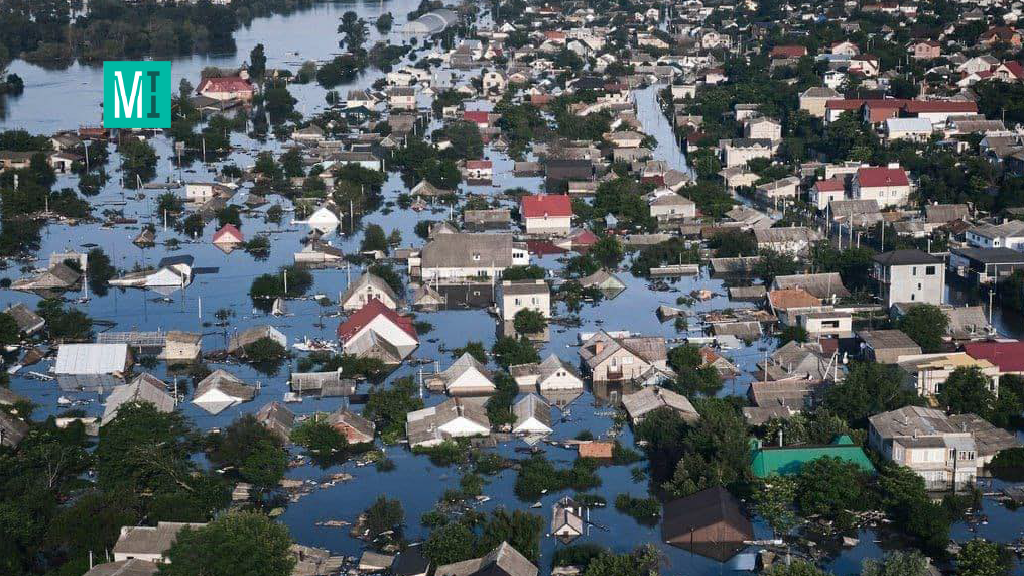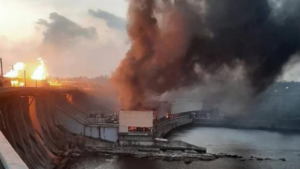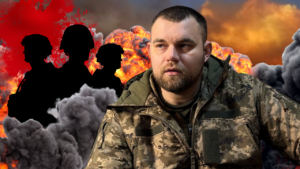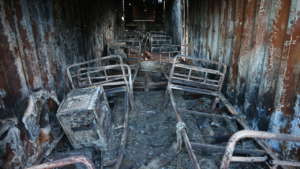“In the military’s perception, Kakhovka Hydroelectric Power Station or the Zaporizhzhia Nuclear Power Plant have no protection because international law is meaningless in times of war. It’s just a piece of paper,” Glen Grant

The destruction of the Kakhovka hydroelectric power plant demonstrated that international law, which explicitly protects dangerous civilian infrastructure from military attacks, is ineffective. MIHR aimed to find the reasons for this, what other facilities are in danger, and if the international community can protect them.
During the night of June 6, 2023, Russian occupation forces blasted the Kakhovka hydroelectric power plant (HPP). According to “Ukrhydroenergo”, due to the engine room detonation from the inside, the plant was completely destroyed and cannot be restored. The Defence Intelligence of Ukraine claims to have evidence of the use of explosives to blow up the Kakhovka hydroelectric power plant. They emphasize that this crime increases the threat of a nuclear disaster, as the fullness of the cooling ponds of the Zaporizhzhia nuclear power plant (ZNPP) depends on the water level in the Dnipro. As a reminder, Russia has been controlling ZNPP since March 4, 2022. It is Europe’s largest nuclear power plant located on the shores of the Kakhovka Reservoir, which “Ukrhydroenergo” predicts will disappear in four days.
A few hours before the explosion of the Kakhovka hydroelectric power plant in the Kupiansk district of the Kharkiv region which locates in the gray zone, Russian troops shelled and damaged a pipeline carrying ammonia, an extremely toxic poisonous substance that poses a deadly threat to humans.
Commenting on the two events, President Volodymyr Zelenskyy said: “One is a story where you have no evidence of a bombing, where it is clear that there is a war going on, there is a gray zone, and in the gray zone, one or another weapon could actually work — most likely, artillery. Yes, the Russian Federation is to blame, but these are the consequences of war. And here (in Kakhovka — MIHR) we understand that this is terrorism. They mined it in advance and did it themselves (blew up the hydroelectric power station — MIHR). We understand that this is a completely different classification.”
Water from the Kakhovka Reservoir is now rapidly flooding the area below the destroyed hydroelectric power plant. Authorities are evacuating people from dangerous areas in Ukrainian government-controlled regions. However, the situation on the Russian-occupied left bank is uncontrollable. Those trapped in the water, particularly in Oleshky and Krynky, are begging for rescue on social media. Here are some of their messages:
“Pushkina Street, 6b, 2 children, a man, a woman, and a pensioner. They are sitting in the attic, if you can, take them away, please.”
“Guys, 165 Dekabristov Street, a woman and a man (the man is wounded). Yesterday they were on the roof together, now it is unknown. Please, help.”
“I’m begging for help! Chasnoka, 21 or 19, two-story building. We urgently need to evacuate 14 people, 3 of them are children, the water is coming to the second floor.”
“Please help! Nyzhnya, 75! The man is alone in the house, it’s tough to move! For God’s sake, help him at least climb to the roof! He’s still alive!”
International law during the war
Analyzing the situation with Kakhovka HPP, international law expert attorney-at-law Andriy Yakovlev notes: “The Geneva Conventions, particularly Additional Protocol No. 1, establish requirements for the general protection of civilian objects. Among them, the natural environment, installations, and dangerous force structures are distinguished separately. The latter include dams and nuclear power plants. That is, international humanitarian law protects them directly.”

At the same time, the same Additional Protocol No. 1 still allows for attacks on dams and even nuclear power plants if the attacking party considers this the only practicable means of preventing the enemy from aiding their military operations.
That is, under certain conditions determined solely by the warring parties, a civilian object (even if its destruction is fraught with catastrophic consequences) may become a target. And no international law can protect it in times of war. Yes, this violates many rules and customs of warfare, but in practice, in the context of an armed conflict, only the opponents decide what can and cannot be attacked. There are no effective legal levers to influence such decisions.
“War is a zone where the law loses its meaning,” said Glen Grant, a retired British Army lieutenant colonel and military expert. “Kakhovka HPP, ZNPP, and the ammonia pipeline in Kharkiv region do not have international protection in the military’s view, because in times of war international law is meaningless, it’s just a piece of paper. And it doesn’t matter whether it’s a civilian or military facility. Russia sees these three objects as important targets at this particular moment.”

Even though it is impossible to prevent attacks, there are legal consequences of decisions made by the military. Especially in the context of international criminal law, as Yakovlev emphasizes: “Article 8 of the Rome Statute of the International Criminal Court states that an intentional attack on civilian objects that are not military objectives constitutes a serious violation of the laws or customs of war and, accordingly, a war crime.” However, here, too, we see a situation where the legal definition of a war crime does not rely on the peremptory norm of prohibiting attacks on civilian objects, but on whether the civilian object was attacked by a military objective. And the targets are determined only by the party to the conflict, and they can be anything: a dam, a hydroelectric power plant, a nuclear power plant, etc. And nothing can protect them.
“By defining civilian objects as military targets, the military’s logic is elementary: will it work? Will it stop, for example, an attack by the Ukrainian army across the Dnipro? “Of course, if you destroy the dam, it will work,” explains Glen Grant, “but we don’t know if the Ukrainians were going to cross the Dnipro. Probably not. Will the attacks on the ammonia pipeline in the Kharkiv region stop anyone? No, they will create a territory that will be difficult to pass through. But I don’t think it will stop the offensive. I would call these targets desperation targets.”
Ecocide, international response, and what’s next
Ukrainian law enforcement officers have launched a pre-trial investigation into the Kakhovka hydroelectric power plant explosion under the article of ecocide. Preliminarily assessing the scale of the disaster, experts say the region’s future is dark. “The consequences for the environment and agriculture will be catastrophic,” says Volodymyr Molchanov, an expert at the Black Sea Center for Social and Political Studies, “There are 6,000 square kilometers of irrigated land in Kherson region alone. People from the left bank will have to evacuate after the liberation of the territories because they will have no means of economic existence. Some communities, such as Ivanivska, will not even have drinking water. These villages get their water directly from the Kakhovka Canal. In addition, rice sowing will disappear in Skadovsk, especially in the arid areas of Prysivaske and Novotroitske communities, where only 300 millimeters of rainfall falls per year, and will become unsuitable for crop production. Melitopol will also lose a significant portion of its tap water supply. Therefore, even if liberated, the population must be evacuated, as the city completely depends on the Kakhovka Canal.”

Reacting to the HPP explosion, the Ukraine 5 AM Coalition, of which MIHR is a member, issued a statement saying that flooding of a large part of the country will deprive residents of Kherson and the temporarily occupied Crimea of drinking water. In addition, it poses a threat of flooding and destruction to dozens of settlements and the operation of the Zaporizhzhia Nuclear Power Plant. Such a large-scale environmental disaster can be qualified as ecocide. The statement reads, “The explosion of the Kakhovka HPP and other environmental crimes committed by Russia on the territory of Ukraine should push the international community to criminalize ecocide as the fifth crime over which the International Criminal Court has jurisdiction.”
At the same time, Olha Reshetylova, coordinator of the MIHR, is convinced that the weak international response to the Kakhovka hydroelectric power plant explosion encourages Russia to commit new war crimes. She convinced: “We must force the world to take measures to deprive Russia of its influence in the UN Security Council and other international organizations. Both the perpetrators and the top military and political leadership of the Russian Federation must be held accountable for the crime of blowing up the Kakhovka hydroelectric power plant and other war crimes committed by Russia in Ukraine.”
Predicting Russia’s further actions on the battlefield, military expert Glen Grant is relentless: “Let’s keep our fingers crossed that there will be no more targets like the Kakhovka hydroelectric power plant. But I have a feeling there will be. Because Russia is getting desperate. And when people are desperate, they start throwing things around. Damming is an act of desperation. What else can they do? A nuclear power plant. I hope not, but it is possible.”








